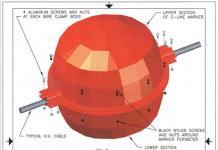Mole - what do we know about this animal? Some people have an opinion about the mole based on famous Czechoslovak cartoons, where he is so small, defenseless and good-natured, doing only good deeds. Others use the cartoon “Thumbelina”, where the “wealthy mole” is a kind of underground Gobsek, imposing, lazy, greedy... And I will not be mistaken if I say that 99% of people have never seen a living mole, and think that this is some kind of underground mouse . Although almost all gardeners have seen the results of his work.
People who are far from gardening believe that the mole is widespread throughout Belarus. From tanned mole skins (which, by the way, are stronger than rabbit and hare skins) you can make children's and adult fur coats, hats, collars, etc.
Moles are beneficial: they eat the larvae of agricultural pests - chafers, click beetles and others; By making passages underground, they loosen and mix the soil layers, and this increases the penetration of air and moisture into them and helps increase fertility.
Moles bring no less benefit in the forest. Thanks to the passages made by moles, seeds of deciduous trees that fall into the soil germinate earlier than any other vegetation. Thus, favorable conditions are created for the natural regeneration of the forest.
However, the owners of “six hundred square meters” know that the mole is attracted by the unusually generous food supply, which is based on the first producer of humus on the entire planet Earth. He (the mole) destroys our best assistant at a rate of 80 to 150 grams per day.
As is known, they cause some damage to vegetable gardens, fields, meadows, forest and fruit nurseries. Without consuming plant food, but digging shallow from the soil surface, they disrupt the root system of plants. In addition, they dig up heaps of earth, which leads to littering of meadows and pastures and makes it difficult for machines to harvest hay. Mole holes are used by mouse-like rodents. What do they turn the lawn into? And what feelings does a gardener experience when he sees that his favorite plant, which has survived the harshest winters, is dying because a mole has undermined it?
Thus, the statement about the usefulness of the mole is, to put it mildly, “far-fetched.” It became clear to me that to do it correctly, you need to know where the mole lives, what it eats, how it reproduces, and what tools are required to catch it. So what should we know about the mole?
Mole. External features
The mole belongs to the class of mammals, the order of insectivores, and the mole family. There are 6 species of moles with 11 subspecies in the CIS. All types and subspecies of moles, generally similar to each other, differ in the size and structure of the teeth, skeleton and some features of their lifestyle.
The animal, widespread in Belarus, belongs to the species European mole, subspecies South Russian mole (Talpa earopaea brauneri Sattnin). The same mole inhabits Ukraine and Moldova.
The appearance of the mole (Fig. 1) is peculiar, which is associated with its underground lifestyle. A short, thick, cylindrical body, pointed at the front and rounded at the back, helps to move better along the passages.
Rice. 1. Common mole (adult animal on the surface of the ground)
Since the mole moves mainly using the front part of the body, it is much better developed than the back part. Its head is, as it were, pulled into its shoulders, so the external signs of the neck are not noticeable and the body turns into a cone-shaped head, ending in a small movable proboscis, on the sides of which there are sensitive hairs - vibrissae.
The mole's forelimbs are especially distinctive. Their feet are wide, spade-shaped, turned outward, have five toes, tightly pressed together, connected by membranes, with long flattened and strong claws up to 8-9 mm long. Bringing both front paws together, the mole digs the soil and pushes the earth to the sides of its underground home. The mole's hind limbs are small, weaker than the front ones, their fingers are without membranes and end in long sharp claws.
When eating and breaking through tunnels, the mole spreads its hind legs wide and rests them on the side walls of the underground canal. The mole has 44 teeth, the upper canines are well developed. Its eyes are the size of a pinhead, poorly developed or completely covered with skin. There are no auricles, although the auditory openings are covered by a fold, the animal’s hearing is well developed (this is facilitated by the high sound conductivity of the soil). He also has a very well developed sense of smell. Tactile hairs are scattered throughout the body, and the mole senses the presence of earthworms through a 60-centimeter layer of soil. A short tail (1.5–2 centimeters), covered with coarse hairs, also helps the sense of touch. Raising its tail up, the mole feels the ceiling of its movement. If the hairs stop touching the ground, the animal becomes alert and often returns along its paths.
The main differences between individuals of different sexes: the average length of a male (from the tip of the proboscis to the root of the tail) is 120-190 millimeters, females - 110-150, weight - 95 and 75 grams, respectively.
Young (new) moles differ from adults, in addition to size and weight, in the silvery tint of their skin. By autumn these differences are almost invisible. It is easier to distinguish young moles from old ones by their gray-black fore and hind legs (the legs become lighter over time), as well as by their pointed teeth (in adults they are more or less worn out).
Mole. Habitats
On the territory of Belarus, the mole is widespread and is found in absolutely all regions, inhabiting a wide variety of places.
The mole lives in meadows (floodplain and upland), forests (young birch trees and deciduous shrubs are more attractive), but prefers edges, clearings, thawed areas, places near roads warmed by the sun, forest clearings, as well as vegetable gardens, greenhouses, orchards, parks of populated areas , rights-of-way and slopes of railways, arable land with cereals and other cultivated plants.
The mole avoids continuous forests, pure spruce forests, pine forests growing on hills with sandy soils, very low and wetlands and floodplain meadows overgrown with sedge and other grasses with a powerful root system.
Thus, the mole most often settles in places rich in humus soil, moderately moist and with enough food (earthworms, larvae, insects).
For him, the presence of earthworms in the upper soil horizons throughout the year is important. During drought and severe freezing of the soil (if there is not sufficient snow cover), they sink into deeper layers and become inaccessible to the mole.
As it declines, the number of areas inhabited by moles also decreases. The habitat of moles also depends on the amount of precipitation and air temperature. The more significant their fluctuations, the closer the mole moves to the forest, where the soil freezes less in winter and retains moisture longer in summer. In places with rugged terrain, moles can avoid a lack of moisture or its excess, moving from lowlands to higher elevations, and regulate temperature conditions by moving from better heated southern slopes to northern ones.
Mole. Mole nutrition
In connection with the digging activity of the mole, the question of its nutrition has attracted the attention of many scientists in various countries. As a result of a number of studies, it has been proven that the mole feeds only on animal food, and the plant residues found in its stomach and intestines come either accidentally with the food, sticking to it, or in most cases from the intestines of the earthworms it has eaten. Plant residues are not digested and are thrown away. He searches for food by making new passages and checking old ones. In these passages, earthworms accumulate, which, moving vertically to the soil surface, enter the mole passage and linger in it, as well as the larvae of various insects. When there is a lack of this food, moles eat small vertebrates. In captivity they eat the meat of frogs, rats, etc.
To replenish the energy expended for movement in the ground, the mole is forced to absorb large amounts of food. This is also due to the fact that the mole’s metabolic processes are much faster than those of other mammals. During the day, the mole eats an amount of food that is equal to or exceeds its own weight (from 80 to 150 grams). If the mole is hungry enough, then it eats the worms immediately on the surface of the earth, and when it is more or less full, it takes its prey to the nearest underground passage and eats it there.
A mole can eat 40 grams of worms within half an hour, while its stomach can hold no more than 20 grams; after 5 hours it is again able to eat the same portion. After satiation, the mole falls into a sleepy state for 3-4 hours, after which it begins to search for food again.
Moles eat earthworms from the head, pulling them between the claws of their front paws. As a result, the worms are cleared of the soil, and the intestinal contents are squeezed out of them. Moles do not swallow food whole; they even chew small insects, with the exception of certain types of earthworms.
In winter, moles eat less than in summer. This can be explained by its less active digging activity and lack of food. Therefore, the weight of moles of both sexes is the smallest in winter.
Moles do not tolerate hunger well. They die 6-13 hours after digestion of the absorbed food, unless new food arrives.
Moles drink very often. They usually set up a nesting chamber not far from the water, to which many additional passages are laid. In captivity, moles drink 4-5 times a day. In the fall, they strive to stock up on earthworms for the winter; to do this, they bite off the ends of their heads. As a result, the worms remain alive, but paralyzed. Then the moles stack them in regular rows against the side walls of the passages.
Mole. Mole breeding
In Belarus, the mating period for moles begins shortly after the snow melts. In the western and southern regions, pregnant females begin to be seen from April 17, and in the northern regions - from May 5-8. Early and cold spring delays this period, which entails a prolongation of the mating period, birth dates, feeding of the young and their settlement. This leads to the prey of a large number of pregnant and lactating females, and consequently to an overall reduction in the mole population.
The duration of pregnancy in females is 35–40 days. The largest number of pregnant females occurs in May. Most females give birth to 6 cubs. On average, there are about 5 cubs per female.
Females usually have one litter per year. However, on the territory of Belarus, especially in the western and southern regions, it was found that 20–25% of females bear litters twice. The second, summer, offspring occurs from the end of June to the end of July. Signs of a female that has given birth to a second offspring are well-developed mammary glands, nipples (4 pairs of them), around which the hair is wiped. In summer, female fertility is lower than in spring: there are about 4 cubs per female.
Feeding the young continues for about a month. At this time, females often fall into traps. Young moles live peacefully among themselves, but as they mature they become pugnacious. At the age of two months, in the middle or end of June, young moles, the size of which does not exceed 3/4 of an adult animal, begin to be caught in traps. They already lead an independent lifestyle. From the end of June - beginning of July, their mass resettlement begins, which ends by the end of August.
In the first days of settlement, young moles run along the tunnels several at a time. Often young moles can be found on the surface of the earth, where they crawl out through holes in passages or molehills. Sometimes it is possible to catch one during the summer, in a course in which all moles go in one direction, up to 50 or more specimens, of which young animals account for up to 75%.
Moles spread very quickly, as they run along ready-made passages at a fairly high speed - up to 6 m per minute. Research by scientists shows that young moles cover a distance of up to 700 m in 20.5 hours, and adults cover 50 m in 20 minutes. Young moles are more prone to movement than adult moles; the latter do not go further than 400 m in 11 months.
When settling, moles encounter small rivers and streams, which they quickly swim across. According to observations, on the Shchors River a mole swam a distance of more than 30 m in 3 minutes. When swimming, the mole holds its head high above the water and quickly paddles with its front legs from the sides, and with its back legs directly in front of itself, while twisting its entire body to the right and left. The railway is not an obstacle to the spread of moles in Belarus. A nest was found 10 m from the Baranovichi-Slutsk railway. Moles even dig passages under the sleepers for many hundreds of meters, and along the embankments the passages stretch for whole kilometers.
Material prepared by: horticulture specialist Buinovsky O.I.
Of course, the fact that they can only live in good soil is a credit to you and your garden. But the damage they cause to planted cultivated plants, flowers and the soil itself as a result of their life activity is not at all encouraging. In a short time, a mole is able to dig many holes, tunnels and passages. Therefore, you should immediately begin to fight them.
In order to function normally, moles need a large supply of food. That is why the best option for them is to settle near a vegetable garden and a holiday village.
Among the main causes of pests are:
- Loose soil in the beds. In addition, it is constantly moistened and dug up from time to time.
- Large amount of food. The fact is that garden pests, such as bugs, worms and others, lay their eggs with larvae in the ground. And this is the best treat for moles.
- No natural enemies. After all, predators avoid human habitation, but for a mole this is exactly what is needed.
Before you start fighting moles, you need to consider a few points:
- As a rule, where there is one mole, there is his whole family, which can reach dozens of individuals. Therefore, when you notice it, remember that there are a couple more nearby, either in the neighboring area, or very close to the first hole that you noticed. This situation creates new conditions - you will have to destroy not just one digger, but a whole brood, the number of which can only be guessed at.
- The mole sleeps peacefully in winter. It digs a hole at great depths, below the dug passages under the soil. There he arranges a secluded, warm and small den. You can spot it by a large mound of excavated earth. If this is not the case, then you can find a mink on humps and hills, since the snow melts away faster on them and it warms up in the warm spring sun. Therefore, you can easily get the mole out of there.
- The passages that moles dig out are full-fledged highways and mines underground. They can grow hundreds of meters throughout the garden. The depth of the underground halls is only 5-25 cm, just in the layer of fertile soil. The planted ones are not of interest to avid diggers; they spoil them quite accidentally during their activities. In the soil layer they destroy all larvae, beetles and worms. But in the pursuit of food, everything in this zone suffers.
- Please note that pests do not have abandoned highways. They have a habit of checking their working shafts almost every hour. Therefore, even if you push through the mine, it will be restored again after some time.
- Please note that moles do not like too much space. They feel a certain insecurity, so they very rarely appear outside. And in the mines themselves, pests move very quickly and it is very difficult to catch them on the move.
- The mole has a very strong body and powerful paws, because it is constantly in motion, digging the ground. IMPORTANT - if you decide to catch it with your bare hands, then you are unlikely to succeed. The animal will simply break out and in addition may bite you or scratch you with its powerful clawed paws. The average speed of a mole moving underground is 5 km/hour. Therefore, special traps and traps are used to catch them.
- Moles are very careful and intelligent animals; they can adapt to any terrain and will not allow you to dictate the rules. When you use the same traps or repellers, they easily bypass familiar dangers. Since they have obvious problems with vision, everything is compensated by their hearing and sense of smell, which are developed at the highest level.
- These are real gluttons. Suffice it to remember the fact that they attack the garden with a whole family and quickly dig tunnels, then in just a few days they can cause enormous damage.
Thus, having taken into account all these points and seeing the first signs of the presence of moles in the garden, you should start fighting them immediately.

Today, there are several types of traps for these animals, or rather, models of the same type. They are inexpensive and small pipes with two caps on both sides. Such traps are not very effective. The animal manages to avoid it, as it discovers a foreign and new object on its territory that was not there before. There is a theory that explains why the mole does not go into the trap - the highways and passages have the rough structure of an earthen tunnel with rough walls, but the walls of the pipe are smooth and he feels this difference.
Of course, you can buy larger traps - they are more effective.
They are specially designed for the pest - the diameter of the pipe is similar to the size of the mink, its walls are rough inside, and the presence of special valves will not release the animal into the wild.
Therefore, if you find a pest in your garden, spare no expense and buy a more effective trap that the animal will not bypass.

With the help of traps you will be able to catch the animal. Even despite his physical strength, the mole is unlikely to be able to escape from the trap. But a person faces a question: how to place a device for catching an animal in an underground tunnel? After all, they do not move on the surface of the earth, and by breaking the passages, setting a trap in the ground, the mole will sense something wrong and dig a new mine. The same can be said about molehills. Do you know exactly what routes the mole takes? You may be able to catch a few animals, but the problem will remain a problem.
To perform this task, it is best to use mole traps.
It is a trap made of wire. Having touched a special spring with its head, the mole falls into a trap. Such devices are installed in two directions towards the tunnel dug by the animal. To do this, you must first remove the top layer of soil near the mole hole using a shovel and place a mole trap. No matter which direction the animal goes, it will definitely fall into a trap.
Please note - you only need to install the mole trap while wearing gloves! Otherwise, the moles will smell someone else’s smell and dig a new tunnel.

Today, there are many facts that indicate that pests are afraid of loud and varied sounds. Having heard them, the mole can go dozens of meters away from the source of the noise.
Homemade rattles, plastic bottles, and noisemakers can serve as repellers for animals.
These devices can be bought at the store or made yourself. But pests may not react to them in any way. In addition, some difficulties may arise, which we suggest discussing:
- So you decided to buy a repeller for the animal. But it is quite difficult to predict in which direction the animal will go - it may go to your neighbor or to a completely different part of the garden. You won’t install ratchets at every step.
- Experts say that installing noisy repellent devices throughout the entire area of the garden and plot is almost impossible. Having driven him away from one plot of land, the mole will brazenly move to another.
There is a theory - if you make a lot of noise, recreating sharp and loud sounds, then the moles will leave your territory forever. In fact, it is difficult to imagine such a picture - how you wander around the garden and plot for days, knocking buckets, lids, while simultaneously blowing a whistle. This is not only funny, but also ineffective - pests will very quickly adapt to such sounds and will feel quite normal.
They also say that you can drive out pests using unpleasant odors.
But the question also arises: are you ready to spread rotten food or rotting food scraps all over your garden? Moles will simply bypass an unpleasantly smelling place, but a landfill in the garden will make its presence felt for a long time.
Thus, these control methods can hardly be called effective, so think carefully before putting them into reality.

Our people are quite inventive, so there are also folk methods of fighting moles. We offer you several ways.
- To do this, you need to break the reed stems, which are about two meters long. Clean them from the “entrails” and place a tube in the reed stem. You need to leave an empty space up to the surface, about sixty centimeters. When exposed to wind, they will make sounds similar to the howling of wind in pipes. Since pests have very developed hearing, such sound irritates them greatly. Within a week, the animals will leave the site forever. The same goes for turntables made with your own hands. They must be installed evenly throughout the garden. An ordinary tin can, which is tied to a rod or stick, is suitable for this.
- Plant a lot of onions, hot peppers, legumes and bulbous flowers in the area. People say that moles do not like the smell of these plants. They will try to move away from this place and will leave your garden in a short time.
- The most effective and more labor-intensive. Along the entire perimeter of the garden it is necessary to dig hard materials to a depth of 70 centimeters. Ideally suited for this are linoleum, slate sheets or tin. Thanks to their dense structure, they will not let animals into your plot from neighboring gardens.
- Very often they use a method such as flooding underground passages.
- This is the best option and it is called a “pan trap”. If you find a fresh molehill, then you need to dig a pan or jar somewhere in the middle below its level. The passage itself must be covered with something dense that will not allow light to pass through. The animal will fall into the pan and be trapped.
- Ambush with three shovels. Block the mole's passage with a shovel. When he comes to repair the damaged passage, block his escape route with the help of a second shovel. Using the third shovel, start digging out the pest.
Therefore, if you find something to your liking, you can try to scare away animals using one of these methods.

You can also resort to other methods of fighting moles, such as:
- The use of poison. Today the market offers several types of toxic substances that can be used to completely destroy animals in the garden. Some of these substances have shown their absolute uselessness in the fight against these animals, and some have had a fairly effective effect. Before you start using toxic products, be sure to carefully read the instructions. The fact is that some substances can be destructive for planting in the area where the land will be cultivable. Also handle such substances very carefully - if they get on your skin, the poison can cause great harm to your health.
- Involve a cat or dog in the fight. This is a rather bold and interesting decision, but only if your pet is interested in hunting, and you, in turn, have not previously poisoned the moles with poisons. Almost every dog loves to dig in the ground, and every cat that is not characterized by a high level of laziness is interested in hunting for prey. There are many examples when they successfully rid the garden of pests of this type. The only question left before us is how to get a dog or cat interested in attacking an animal? The answer is quite simple - you just need to watch the mole holes for a while, and as soon as you see slight movement, take your pet there. The first catch will serve as the best incentive for further successful mole hunting.
- Plant harmful plants for the mole. Plants such as black beans, hemp and beans are good at fighting animals. They have an unpleasant odor for the animal and he will try to avoid such places.

The surest way to never fight moles in your garden in your life is to prevent their untimely appearance in time. This is a fairly expensive process, but effective.
The best option and correct method is a special fence over the entire area of the garden.
It will not allow the animal to enter the area. As a fence, you can use slate, roofing felt folded in several layers or galvanized steel mesh. It needs to be buried fifty centimeters along the border of the garden. Please note that the fence should protrude slightly above the ground. This way, pests will not be able to dig a tunnel and get into your garden.
Summarizing all of the above, the most effective ways in this matter are:
- Creation of embankments over the entire area of the garden. Their depth should be from 35 cm. They must be filled with sand and crushed stone. Having encountered such an obstacle, the animal will not dig further.
- Instead of embankments, you can use hard materials - linoleum or slate slab.
- Be sure to plant a crop such as black beans or any other legumes in your garden.
- Additionally, place electronic repellers around the area.
- You can place small wind propellers in your garden. They will create vibration and noise that will scare away pests from the area.
More information can be found in the video.
Shrew or mole how to determine
Hi all! Sometimes neighbors come to me with such strange questions that it seems as if they haven’t lived on their plots for ten years.
Last spring, a neighbor complained that after the winter there were a lot of small earthen slides all over the property.
She couldn’t understand whether moles were causing her this inconvenience or other inhabitants of the underworld. Want to know how to tell if a shrew or a mole is digging holes? What actions can be taken to prevent their activities? I will describe everything in detail in the article below.
Moles, mole rats and shrews. Similarities and differences between rodents
Information about these underground inhabitants is often contradictory, since their way of life is not fully understood and has many blank spots.
The most incredible rumors and “heartbreaking” stories are being spread about the benefits and harms of these funny animals, especially among summer residents, more like fiction and fantasies, since shrews and moles are blamed for all imaginable and unimaginable misadventures of gardeners, blaming almost all of the poor animals “ dogs."
So, how to distinguish a mole from a shrew, what is the difference between them and in fact, these little animals are so dangerous and harmful. Let's figure it out.
Few people have seen this animal in person, since it lives underground. The shrew looks like a mouse, but has a more elongated muzzle with an elongated proboscis. Her fur is soft, fluffy, velvety, gray in color. The ears on the head are practically absent, and the eyes are very small and blind.

The shrew reaches eighteen to twenty centimeters in length and has a very long tail. The baby's weight is no more than fifteen grams.
Predatory animals such as foxes, dogs and domestic cats sometimes catch and strangle shrews, mistaking them for mice, but do not eat them, because thanks to the musk gland, the animal emits a strong unpleasant odor, which discourages its pursuers from any appetite.
Only some species of birds of prey do not have an aversion to shrews, such as owls and small wild animals like ferrets and weasels, for which the unpleasant spirit emanating from the animal is not a hindrance.
Like all of its close relatives, such as hedgehogs and moles, the shrew belongs to the order of insectivores and, like most rodents, lives in burrows, feeding mainly on animal food. Scouring the ground in search of food and using passages left by mice and other rodents, shrews devour insects, worms, larvae, and other small animals.
Since the shrew has a powerful metabolism and cannot go without food for a long time (no more than seven to nine hours at a time), it has to constantly get food and eat more food during the day than it weighs.
The most common are the two types of shrews:
- Shrews (lat. Crocidura)
- Shrews (lat. Sorex)
As the names of the animals suggest, some have white tips of their teeth, while others have brown tips. In addition, shrews are usually much smaller in size.
Since the shrew is a predator, it is beneficial by destroying the larvae of harmful insects living underground. In addition, these animals excellently loosen the soil, saturating it with oxygen and thus aerating the soil.
The mole (lat. Talpa europaea) is a close relative of the shrew. It has powerful front paws, well adapted for digging the ground, a muzzle with a maneuverable trunk and a short tail. The animal reaches twenty centimeters in length.

Like the shrew, the mole is an underground dweller, building an intricate system of passages, and appears on the surface only in an emergency. The mole throws out all the excess earth that is formed during the construction of passages. These earth piles in the form of small tubercles are popularly called molehills and are a clear sign that a mole has settled in this area.
It should be noted that the mole does not inhabit vegetable gardens and personal plots, but can live in the garden if the soil is sufficiently moist.
Like the shrew, the mole is a predatory animal, consuming large quantities of earthworms and earthworms, actively feeding on the larvae of beetles, butterflies, beetles and other harmful insects, thereby bringing invaluable help to gardeners and summer residents.
Well, finally, we have reached the true pest, since it is the mole rat that is the threat of vegetable gardens and summer cottages, rampaging and causing outrage to the fullest.
For mole rats, the animal food that its relatives feed on is strictly contraindicated.

Like all of the above-mentioned “relatives” of the mole rat, he diligently digs passages and holes and leads an exclusively underground lifestyle, leaving the shelter only once in his life - at the moment when, as a teenager, he leaves his father’s house to begin an independent adult life.
Like a mole, a mole rat can be detected on a site by the mounds formed on the surface, reminiscent of small earthen slides.
In addition to the common mole rat, there are several more species of this rodent: “sandy”, “Pontic”, “Bukovinsky” and “Podolsky”, and all these species (with the exception of the common one) are listed in the Red Book of Ukraine.
It is noteworthy that the habitat of the common mole rat is limited only to the left bank of Ukraine, since, apparently, the Dnieper River is an insurmountable barrier for the animal.
The mole rat, unlike its fellows, is a herbivore and feeds on underground parts of plants. In wild natural conditions, the pest consumes mainly bulbous crops, acorns and eats up seedlings of oaks, maples, and other deciduous trees, and when it gets into the garden, it becomes a real disaster, since it destroys root crops, bulbs and tubers of cultivated plants.
As mentioned above, this type of rodent, due to its secretive habitat, is still poorly studied and keeps many secrets.
In appearance, the mole rat has a rather blocky body, resembling a voluminous cylinder up to twenty-five centimeters in length. The rodent's head has a flattened shape. The main digging tool of the mole rat is the huge sharp incisors sticking out. In place of the eyes there is a wide fold of skin, completely covered with bristles. The animal's skin is yellowish-brown in color.
Attention!
It is noteworthy that the organs of touch in the mole rat are individual hard hairs protruding from the fur, thanks to the sensitivity of which the animal receives information from the outside.
An interesting fact is that the fleas living on the animal have also been successfully assimilated and, like their owner, are completely blind.
It is a well-known fact that the mole rat creates a significant supply of food, storing it for the long winter period. For example, eighteen (!) kilograms of potatoes were found in the pantry of one prudent and hardworking animal.
However, scientists have determined that the daily rate of consumption of plant food for a mole rat is equal to its own weight (which is about half a kilogram of weight), that is, with such a rate of consumption of these products, there is clearly not enough for the whole winter. It is possible that during the dry winter period the animal falls into a state of suspended animation, which is why the metabolic process slows down, and the mole rat feeds only from time to time.
The main habitat of the mole rat is located at approximately a depth of ten to twenty-five centimeters and the burrows, as a rule, are located in the soil layer in two tiers.
In the upper tier the animal feeds (since its main food supply is located at this depth), and in the lower tier the mole rat builds nests, creates its own pantries and establishes latrines. It is noteworthy that the lower “floors” can go to a depth of up to four (!) meters, but generally do not exceed eighty centimeters.
While building its tunnels, the animal loses a lot of energy, so it has adapted to overcome obstacles and heavy areas of the ground, using the technique of creating small earthquakes, for which it makes head blows and then evaluates the reflection of seismic waves.
This method allows the mole rat to break through burrows with less labor, since it was calculated that the total length of the burrows of one animal can reach three hundred and sixty (!) meters in length.
The method of tapping the head on the ceiling allows individuals of different sexes to communicate with each other during the mating season.
The mole rat is essentially a hermit, but in March it begins to look for a mate, and already in April, offspring appear in the newly-minted family, consisting of two or more (up to six) cubs, which the mother feeds with milk.
Pest control methods
Pest control methods can be divided into two main groups:
- Deterrent measures
- Exterminatory measures
It has long been noted that moles and mole rats do not like the strong odors of some plants, and in particular they do not accept the pungent scent of mint and wormwood. The imperial hazel grouse also repels these rodents well, the bulb of which emits a strong smell that repels the animals.
Practice has proven that if several rows of parsnips are planted in a rodent's habitat (you need to find a plant variety that has a long root), the mole rat will leave this area. Black elderberry and medicinal black root repel pests well.
There are also different types of repellers that make sounds and produce vibrations. For this purpose, on a personal plot, it is necessary to drive wooden stakes into the ground, into which a regular impeller is inserted on top.
When the wind blows, the impeller rotates and creates a hum and vibration, which mole rats clearly do not like. For the same purpose, specially cut tin cans of beer or cola can be placed on wooden pegs, which, when rotated, create a similar effect.
Some gardeners and gardeners bury a metal mesh (chain-link) around the perimeter of the site and thus protect themselves from uninvited guests. The only difficulty is that you have to bury the net quite deeply (up to a meter deep), taking into account the depth of possible holes in the lower tier.
But the most effective method of pest control is its physical extermination. For this purpose, either chemical or mechanical means are used.
The chemical method of control is the simplest, but it is fraught with serious consequences, since domestic animals and even people can suffer from the strongest poisons, which belong to the group of phosphites (the poison has a negative effect on all warm-blooded organisms).
Therefore, before using chemistry, it is necessary to try methods that are safer and less harmful to the environment, because the use of poisons can ultimately result in tragedy.
The mole rat, as a rule, leads a hidden and solitary lifestyle, therefore, having driven or exterminated the animal from the site, you can finally take a deep breath.
source: http://agrostory.com/info-centre/knowledge-lab/kroty-slep/
Moles (mole rats), shrews, mole control in the country, traps
Mole rats, shrews and moles live in large numbers in summer cottages. However, not all of them are harmful and we must fight them; we will also get acquainted with useful “underground inhabitants”.
Shrews
It is very rare to meet them and examine them - they do not like to show themselves, although they are active around the clock. Unless you go out into the yard early in the morning, and on the grass are the fruits of a tireless cat’s night hunt. Take a close look at the animal.
He doesn’t look like a mouse at all, his muzzle is elongated into a proboscis, his ears are almost invisible, his eyes are tiny, his fur is velvety. But the cat didn’t eat the animal because it smelled very bad, which was due to the musk gland, which is present in many species.

Meet the shrew, the closest relative of everyone's favorite hedgehog. Shrews, hedgehogs, and moles all belong to the order Insectivores (Sorisiformes). Just like rodents, they live in burrows, although they prefer to use passages left by rodents. The basis of their diet is animal food.
With the tirelessness of the eternally hungry, shrews search for insects, earthworms, and often attack small rodents. They have a very intense metabolism, they can live without food for only 7-9 hours, so they have to eat more food per day than they weigh and search for it around the clock. Shrews (Sorex) and shrews (Crocidura) live in our area.
In addition to other differences, the tips of the teeth of shrews are brown, while the teeth of shrews are white, the body length is 6-8 cm. These crumbs are of great benefit because they loosen and thereby saturate with oxygen (aerate) the soil, and also destroy the larvae of harmful insects .
Their close relative, the mole (Talpa europaea), has velvety black fur, powerful burrowing front paws, a short tail and the same muzzle with a movable proboscis, and its body length reaches 20 cm. The mole rat is often incorrectly called a mole.

The only thing they have in common with the mole rat is that, like the mole rat, the mole is an underground dweller and builds a complex system of underground passages, which it leaves only as a last resort. When passages have to be laid deep and in dense soil, the excess earth is thrown to the surface through temporary passages in the form of small piles, so-called molehills.
From these heaps one can understand that a mole lives here: molehills are smaller in size than mole rat emissions, and moles do not settle in vegetable gardens. But in the lowlands, in damp areas of the garden, it can settle.
Attention!
The benefits of a mole are the same as those of shrews, and although he is a big fan of earthworms, he also destroys in large quantities the larvae of click beetles, which we call “darts,” and the larvae of May beetles and other beetles. So not all the animals that dig holes on your property are pests!
The mole rat is similar to the mole only in its manner of throwing out soil when digging holes and its exclusively underground lifestyle. You can see him extremely rarely; he leaves his underground galleries once, leaving his native nest at a young age.
The appearance of the mole rat is very unusual, the body shape resembles a plump cylinder, the geometric perfection of which is not disturbed by either the ears or the tail, since they are underdeveloped. The large head of the mole rat is flattened in the shape of a wedge.
He is completely blind, in place of his eyes a thick fold of skin has formed, densely covered with bristly hair, even the fleas living on him are also blind. The body of the animal is covered with thick silky ocher-brown fur, in which there is no down and guard hairs that are familiar to us; Hard hairs protruding from the fur are organs of touch.
The mole rat's legs are short and weak; they do not take part in digging; the main digging tool is huge incisors sticking out. The lips are equipped with folds that close the mouth so that the earth does not get there during underground robots. The body length of the mole rat is 20-25 cm.
In addition to the common mole rat, there are four more species - the sand mole rat, the Pontic mole rat, the Bukovinian mole rat and the Podolsk mole rat. All of them, except the common mole rat, are listed in the Red Book.
Scientists studying these rodents note that the number of mole rats in the west and north is also declining. Let us also note that the common mole rat lives only in Left Bank Ukraine; the Dnieper is an insurmountable barrier for it.
What do they eat?
In the wild, mole rats feed on all kinds of green and underground parts of plants; on occasion, they eat sown acorns, seedlings and young seedlings of oak, maple and other deciduous trees; an important part of their diet consists of bulbous trees.
In a cultivated landscape, they are most numerous in crops of perennial grasses and vegetable gardens, where they subsist on root crops, bulbs, and tubers. The lifestyle of these animals is still poorly understood and still leaves many questions. For example, they are known to stock up for the winter.
At first glance, the mass of prepared food is impressive: 15-18 kg of potatoes in one pantry, in other pantries - up to 14 kg of tree roots and sprouted acorns.
But if in the warm season the animal eats a mass of food per day approximately equal to its body weight, and this is about 500 g, then it becomes clear that these reserves will not be enough for the whole winter; apparently, in the cold season their metabolism and food slows down. less is consumed.
Mole holes of mole rats
Mole rats have burrows in two tiers: a complex system of horizontal feeding passages is laid at a depth of 10-25 cm. It is in this soil layer that the underground organs of plants are located, which the animals feed on as they move.
From them, passages lead steeply down to the lower tier, where nesting chambers, storage chambers and latrines are located. The lower tier is located at a depth of 80 cm to almost 4 m. When digging holes through a temporarily constructed hole, the earth is pushed to the surface with the help of the head, forming a heap of impressive size.
When it becomes difficult to push out portions of the earth, the mole rat fills the hole with earth and at the end of the move makes a new one and throws out a new pile of earth. The total length of the passages of one mole rat reaches 275-360 m.

In late autumn, the second construction season begins, which is not visible to us living on the surface - mole rats expand and improve the passages and chambers of the lower tier, and the earth is not thrown to the surface, but clogs the upper feeding passages with it.
While making passages and looking for food, they lose a lot of energy; for this reason, mole rats, trying to get to the roots and overcoming obstacles in their path, use the technology of small earthquakes.
They behave underground like seismology specialists, hitting their heads on the ceilings of the corridors they have dug, creating micro-earthquakes and, assessing the strength of the reflection of seismological waves, digging tunnels that are convenient for them with less energy.
Parental worries
Continuing the topic of seismology, we will add that they communicate with each other by tapping their heads on the ceiling of the passage.
For most of the year, mole rats live as hermits; the dating period begins in early March, and already in early April, happy mothers feed milk from two to six cubs.
Just imagine - the beginning of spring, it is still cold and hungry, but not for the mole rat; apparently, the main food reserves have been saved for this time. Mole rats give birth to only one offspring per year, and they begin to reproduce at a very respectable age of two or three years, compare with mice and voles!
The importance of mole rats and moles and their digging activities
In places where there is a massive impact of mole rats, the thickness of the humus horizon increases as a result of digging, mixing plants with soil, sprinkling plant substrate, and enriching the soil with animal secretions.
Its lower boundary drops by 10-20 cm, the humus composition improves, that is, the soil formation process becomes more intense. In addition, the seeds of many plants germinate on earth emissions, which cannot germinate on undisturbed areas of the earth, and thus the species diversity of plants increases.
Not only for plants, but also for animals, the digging activity of mole rats is very useful - various rodents settle in the holes, and the passages are populated by predators: weasels, ferrets.
They are such extraordinary mole rats. But when they settle in the garden, they cause a lot of damage to our crops.
Methods of fighting moles
Methods for protecting garden plots from mole rats will be divided into repellent and exterminatory.
Deterrent measures. Among the repellent methods, the most popular are sound repellers and planting certain types of plants.
Attention!
The success of these methods depends on many components: the location of your site, the proximity of fields of perennial grasses, hay meadows to it, the composition and placement of the crops grown, whether there are abandoned vegetable gardens nearby, etc. It’s up to you to choose and check their effectiveness.
Fighting moles with folk remedies. Moles do not like the smell of mint and wormwood. Young trees of the most valuable varieties can be sprayed with mint oil. Plant imperial hazel grouse in your summer cottage. The bulbs of this plant emit a smell that repels rodents.
Near the holes you can place repellent plants of black root, branches and leaves of black elderberry. These measures help against all rodents. We can only add that the mole rat cannot tolerate the presence of parsnips. If you sow parsnips along the perimeter of the garden in 2-3 rows, namely the long-rooted varieties, the mole rat will leave this area.
Fighting moles with your own hands. There are many designs of homemade sound repellers. For example, wooden pegs are placed on the site, and a wind impeller is attached to them. The impeller is not nailed too tightly to the peg, so that at the slightest breath of wind it immediately begins to spin. This creates a hum in the ground, which mole rats really don’t like.
You can bury several champagne bottles upside down. It is necessary to bury it at an angle of 45°, with the neck protruding 2-3 cm above the surface.
It is advisable to bury the bottles taking into account the direction of the prevailing winds, so that the winds create noise in the bottles as often as possible. Empty metal beer cans are placed on wooden pegs; the effect is similar.
Collections of ornamental plants can be protected by planting bulbs, for example, in plastic bottles that have been previously punched with holes. You can also fence the flower garden with a metal mesh, which must be dug into the ground at least 80 cm, that is, it must be buried deeper than the feeding passages, taking into account the lower tier of the passages.
How to destroy moles. Still, the most effective method is mechanical extermination of rodents. I will not write in detail about chemical methods - I am a strong opponent of them. Since the chemicals approved for use belong to the phosphide group.
These substances are the strongest poison for all warm-blooded animals; they prevent the process of blood clotting. The use of such products in open ground can be tragic for many domestic, wild animals and even humans. I absolutely do not recommend using them!
There are several options among mechanical catching methods. If your site is located near a village, it is easier to contact its residents. As a rule, there will definitely be at least one experienced craftsman who deftly sets special traps. In addition, some summer residents are lucky - they have a tireless hunter cat or an adventurous hunting dog.
Many pets successfully catch mole rats in their areas. But if you don’t have a skillful neighbor and your pets have no desire to save the owner’s garden, you’ll have to get down to business.
So, we already know the design of a mole rat’s hole and therefore, armed with a trap and knowledge, we get down to business. First you need to find the latest release of earth, this means that the mole rat is digging somewhere nearby. By the way, a dog can help here, if you have one, it will immediately let you know whether or not it’s worth digging up what you think is a fresh mound.
Then, having thrown away a pile of earth, you should dig a hole in the hole (earth emissions form here) about 40 x 40 cm. Here you will find the main passage in which you need to clear both holes. The mole rat does not like drafts and after about 20 minutes it will block the passage from which it digs.
Well, having found the passage where the animal is digging, destroy the soil plug and, retreating about 5 cm in depth from the beginning of the passage, set a trap for the mole rat. He will return to the beginning of the move to close it and will inevitably fall into the set trap.
The mole rat is a territorial animal that leads a solitary lifestyle, therefore, having driven away or exterminated the animal on the site, you can live in peace for some time.
source: http://gardenx.ru/sad_i_ogorod/kroty_slepyshi_zemlerojki_borba_s.html
The smallest mammal on Earth
Since ancient times, farmland owners have had a bad relationship with the shrew. Previously, the epithets “dangerous”, “aggressive” and even “poisonous” were applicable to it. Over the years, people have managed to reconsider their attitude towards small animals and learn to benefit from their proximity to them.
What kind of animal?
The shrew is often identified with a mouse due to the external similarity of these far from closely related animals. After reviewing their position in the animal kingdom, scientists assigned these individuals to the order Shrews; previously they were classified as insectivores. Mice are members of the rodent order and have little in common with insectivores.
Relatives of shrews are moles and hedgehogs. With more careful observation, one can discover similarities between these animals in their methods of movement, nutrition and lifestyle.
Shrews are one of the smallest ubiquitous animals. Some of them have the honorary title of being the smallest mammal on Earth.
The giant shrew is considered a giant among shrews, reaching a length of 12 cm. You can learn more about these animals in the article about the types of shrews.
Shrews are the most common subfamily of tiny underground insectivores, including many species: common (forest), dwarf, tiny, house, water, elephant. The article dedicated to common types of shrews, in addition to interesting information, contains many photographs of our little neighbors.
Appearance and structure
The shrew looks like a mouse: a small head with tiny eyes, a short neck, a body set low on thin legs, and a long tail. The size of the animal is also “mouse” - its length rarely exceeds 10 cm. The entire body of the shrew is covered with short, thick brown hair.
The fur of the animal is constantly lubricated with the secretion of special glands that produce a fat-like substance with a repulsive odor. This is another cunning acquisition for the defenseless shrew, protecting it from the attacks of formidable predators.
During evolution, shrews lost their acute vision. They navigate using their sense of smell, using their nose, located at the end of an elongated, pointed muzzle, as a compass-navigator. Widely spaced ears pressed to the head are necessary for the animal for echolocation.
The ends of the animal's sharp teeth are covered with strong protective brown enamel, which wears off towards the end of the shrew's life. It is not surprising, because the small animal spends most of its short life eating.
You can see what a shrew looks like in the photo below:

Nutrition
Shrews eat an incredible number of insect pests: beetles, mole crickets, caterpillars, wireworms, and woodlice that live underground. In a day, the animal can destroy hundreds of grams of insects, which is 4 times the weight of the little hard worker itself.
Attention!
By eating voracious pests, shrews bring undeniable benefits to owners of summer cottages and vegetable gardens. Moreover, the underground passages along which animal shrews move provide drainage for plant roots.
The animals are not distinguished by their foresight: they often steal their food reserves for the winter during the warm season. Unable to withstand prolonged winter hunger, they die. You can find out more interesting things in the section on the nutrition of amazing animals.
Reproduction
During its short life, the shrew leaves up to 6 litters. At one time, from 3 to 10 tiny blind babies are born.
Is the shrew a mammal or not? Without a doubt, the answer is yes, because... a caring mother carefully feeds her babies with milk, gradually transferring them to an adult diet.
How long do shrews live? The animals become completely independent by the end of the 3rd week, which is not surprising, because the maximum life expectancy of shrews is only 1.5 years.
Shrews have long ceased to be unknown and mysterious to humans, but debate about the benefits and harms of small insectivores still continues.
“I heard a fuss underground,
A mole crawled out of a hole, a blind monk..."
The mole is a small, palm-sized insectivorous mammal. This animal is not rare. Lives preferably in places where there is loose, fertile soil. The mole spends almost its entire life underground, in deep holes and passages, so its life is mysterious and inaccessible to observation. It is rare, but it is possible to see an underground inhabitant. And it is immediately clear that it is adapted exclusively for underground life.
The two very large front paws are designed for digging. And also the nose, which is very sensitive to odors, is designed for rough work - the mole drills the ground with its nose, rows it with its paws like an excavator and pushes it back. The penetration speed is 30 cm per minute.
The eyes and ears are covered with folds of skin and hidden in the fur to avoid contamination with soil. The mole's fur lies equally in any direction, and the mole successfully uses the "reverse" move. The mole has a tail. During movement, the tail indicates the height of the tunnel.
The underground animal has very poor eyesight. The eyes are very small, but if necessary, the eyeball extends, and the mole can see, well, at least what is outside - night or day.
Having chosen a suitable place to live, the mole equips it well. He has a place where he rests and sleeps, a gallery of passages, hunting grounds and storerooms. Mole hunting is hard physical labor, tirelessly digging the ground in search of food.
The mole recognizes nothing but meat and eats a lot of it every day - as much as he weighs. It eats everything it encounters during excavation - insects, their larvae, beetles, mole crickets. But the main food is earthworms. He eats them with preliminary processing - he grabs them with his teeth and pulls them through the clawed ridge of the front paw, cleaning the surface of the prey.
The hunt goes on day and night. The mole's twenty-four hours of the day are divided only into hunting and resting time. He must eat every four hours. Twelve hours without food is the limit that means death. For this reason, moles do not hibernate during the winter, since in winter they find enough food underground.
However, in winter there is less prey, so in the fall the animals intensively stock up. Around his “bedroom” he has warehouses everywhere. To prevent the prey from spreading, the mole disfigures it, but leaves it alive.
Occasionally, coming to the surface of the earth, a mole can catch a vole, a lizard, a frog, or steal a chick from the nest. In search of prey, the mole's very fine hearing, smell and touch replace poor eyesight.
The animal not only eats a lot, but also drinks a lot. One of the tunnels of its labyrinths certainly leads to a river, a pond, or at least a puddle. If there are none, the mole digs deep vertical wells. Water often floods the passages during rains, but the underground inhabitant swims well.
The mole is an unfriendly creature, grumpy, quarrelsome, and bloodthirsty. He doesn't have any friends. He lives as a hermit and does not tolerate anyone in his domain, especially his relatives. Meets the enemy with combat.
Without the caresses characteristic of many animals, moles form a gloomy family union and give birth to four or five completely helpless, naked, blind moles. The little one feeds them with her milk.
In nature, the mole has many enemies: foxes, martens, hedgehogs, owls, storks, crows and other predators. Due to the fact that their gray velvety skins turned out to be fragile for fur coats and hats, humans were not included in the mole’s list of enemies.
Moles not only damage farmland, but also bring certain benefits: they destroy mole crickets, May beetle larvae, and slugs.
Valentina Lisitsina. The Epoch Times
What is it like to live underground? It is difficult for us to answer this question. Humanity settled on the surface of the planet, only occasionally delving into its depths. We need sun, clean air and at least some space, otherwise we begin to waste away. This is true not only for humans, but also for the vast majority of mammals. Even though many of them live in burrows, they hunt and breed outside.
But, of course, every rule has its exceptions. Moles We are sure that sun and space are greatly overrated.
Storm of earthworms
Not all of us have seen a mole, but it’s not difficult to imagine one. This is a small animal, no more than 20 centimeters in length, covered with smooth, beautiful fur. An elongated mobile nose, tiny blind eyes, flat wide paws with hefty claws - this is the appearance of a typical mole. They have settled in many regions of the planet, but they prefer those where the soil is wet and the winters are not too harsh.
A mole's entire life is spent endlessly digging holes and searching for food. Its metabolism, like that of other shrews, is prohibitively high - a day a mole needs to eat as much as it weighs. Without food, a mole will live no more than 15 hours and then die of starvation. This leads to the fact that the mole not only hunts insects, but also creates huge reserves.
Its main prey—earthworms—faces a terrible fate. The mole takes advantage of the fact that the worm is not easy to kill, bites its head, thereby immobilizing it, and takes it to its underground warehouse.
Such warehouses can store up to several hundred paralyzed worms, which the mole eats on hungry days, especially in winter. If earthworms could communicate, surely moles in their stories would appear as the most terrible of monsters. But this is not given to worms, especially those with a bitten head.
Owners of holes and tunnels
A mole's burrow is not limited to food storage. Any self-respecting mole digs itself a cozy underground nest, where it sleeps between feedings. It is located at a depth of one and a half to two meters, as a rule, under the roots of a tree, bush, large stone or human dwelling.
This prevents predators eager to feast on the mole carcass from taking the digger by surprise. The mole carefully lines his bedroom with dry grass and leaves, keeping it clean and tidy. All moles are convinced loners, and get along with each other only during the mating period.

The rest of the time they jealously guard their territory, attacking any animal that gets into their tunnels, including other moles. In a fight for a hole, a fatal outcome is not excluded, and, moreover, the winner is not at all against eating the loser. This is mole-style cannibalism.
The mole, moving underground, pushes the earth apart in such a way that a smooth, non-creeping tunnel remains behind it. The passages are a system of multi-tiered galleries, mostly located parallel to each other. The domain of one mole can extend for many hundreds of meters - these are mainly hunting grounds. In them, the mole places peculiar traps for the worms - odorous marks made of musk.
However, the smell attracts not only insects - shrews often climb into holes, eating the mole's prey before its arrival. Other animals such as mice and stoats can also use the tunnels. At your own peril and risk, of course.

Moles are small animals, but when angry they are extremely dangerous and in their burrows they are much more effective than strangers. Yes, their vision is rather weak, but their sense of smell is at the highest level, as well as the ability to navigate underground. If necessary, the mole crawls backwards with extraordinary ease.
Negative and not very
Another sign that people do not like to look underground is the very scanty mention of moles in the legends of the peoples of the world. Let's try to remember some fairy tale about moles? That's right, Hans Christian Andersen's "Thumbelina" immediately comes to mind, the main character of which they wanted to pass off as a nasty old mole.
To the credit of the great storyteller, it should be noted that he depicts the mole as a character, although negative, but at least rich and neat. Another famous mole is a cartoon character by Czech artist Zdenek Miller. He is comical, quick-witted and charming and thus slightly raises the reputation of his tribe.

Of the ancient legends, moles play at least some role only in Slavic and near-Slavic mythology. It was believed that the mole, living in the bowels of the earth, occupies an intermediate position between animals and reptiles. Aversion to sunlight and blindness only strengthened the moles in this unenviable role.
In addition, our ancestors associated molehills - heaps of dug earth on the surface - with graves, and the appearance of a mole was considered a bad omen. In Serbian, Macedonian and Bulgarian legends one can often find the motif of the origin of moles from people. In one of them, the children of a peasant were always quarreling over the land they inherited. They annoyed their father so much that he eventually cursed them, thereby turning his sons into moles. Each of them had 40 holes, but they were still cramped.
In another tale, a cunning farmer wanted to appropriate someone else's field for himself. To do this, he buried his own son on it and, in the presence of a judge, asked whose land it was. "Your your!" - a dull voice rang out from underground, and the peasant won the case. But when he began to dig up the offspring, it turned out that he had buried himself too deep, turning into a mole.
Fight for vegetable gardens
Moles feel quite comfortable underground, although they live alone, and their lifespan is short - no more than five years, including in captivity. They have few natural enemies; predators generally disdain moles because of their pungent musky odor. But people once actively hunted underground diggers.

The fact is that mole fur has a unique property - it grows perfectly straight on the skin and lies in any direction when the animal moves underground. Since the 19th century, mole skins have been highly valued in Russia and Europe for their durability and beauty. But these days the mole fishery is very small.
We notice animals when they are beneficial or harmful in one way or another. Moles excelled in both areas. It is believed that the mole brings considerable benefits by loosening the soil, enriching it with organic substances and actively eating harmful insects. But farmers, as a rule, are not enthusiastic about mole activity, since the animals often dig their tunnels extremely close to the surface, damaging the roots of plants.
At the same time, getting rid of a mole is damn hard! It would seem, what kind of intelligence can be expected from tiny blind worm eaters? Surprisingly, quite high. In the fight against moles, substances with a pungent odor, poisons, traps and a variety of noise devices are used.
The star-nosed mole (or star-nosed mole) is a small mole native to the humid regions of Eastern Canada and the northeastern United States.

But, sensing an unpleasant odor or encountering a trap, the mole will skillfully bury the dangerous section of the tunnel, digging out a new one instead. Even if you manage to drive the mole away from its habitat, rest assured that it will definitely return in a couple of months, when you least expect it.
Mole to man mole
The entire depth of hostility towards moles can be seen in an old Slavic superstition. On Holy Thursday, the peasant must take a poker and “ride” it around his garden, saying: “Mole, mole, don’t come into my garden! On the day of Maundy Thursday you will... have a poker.”
Apparently, it is assumed that after such an insult, the mortally offended moles should move far away. Although, given the huge number of moles to this day, ancient indecent spells do not work on them either.
It just so happens that we either don’t notice moles or don’t like them. On the other hand, moles don’t really need our love either. It is impossible to tame a mole; there is really nothing to take from it except its skin. Moles do not value the company of even their own kind, what can we say about the huge primates, who are completely unsuited for digging durable and cozy holes?
Not all of Mother Nature's creatures are designed to befriend or threaten humans. In the case of moles, mutual silent respect is enough.
Sergey EVTUSHENKO




















